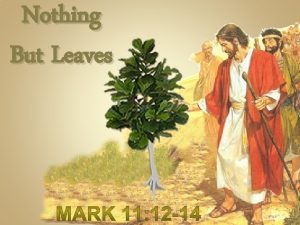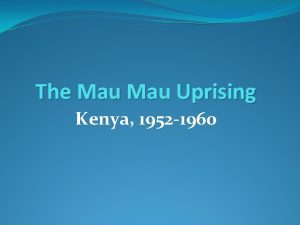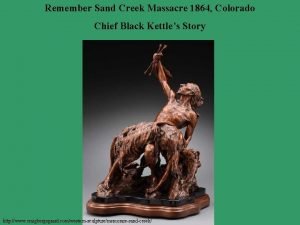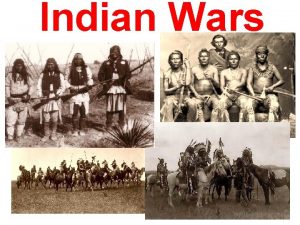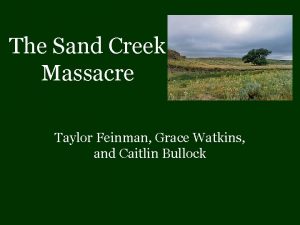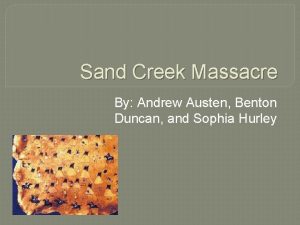THE SAND CREEK MASSACRE Nothing lives long Only
















- Slides: 16

THE SAND CREEK MASSACRE “Nothing lives long. Only the earth and the mountains. ” -White Antelope, Cheyenne death song, November 29, 1864

The Civil War leads to Indian Wars • As army troops were sent east to fight in the Civil War in the early 1860 s, problems grew between whites and Plains Indians • Promised provisions for tribes didn’t get delivered – some Indians took to begging for food, others became violent. • In reprisal, whites took violent action against Indians – at Sand Creek, in Colorado, innocent Cheyenne Indians were attacked by the 3 rd Colorado Volunteer Militia in reprisal for violence by other Cheyennes.

Black Kettle • Black Kettle was a Cheyenne leader known as a “peace chief, ” because he consistently counseled his people to live in peace with whites, not to make war. • In November 1864, Black Kettle’s people were camped at Sand Creek, about 170 miles southeast of Denver.

John M. Chivington • A radical abolitionist before the Civil War, Chivington was a Methodist parson known for his fiery sermons. • A bear of a man at 6’ 4” and over 250 pounds, Chivington believed it was his mission from God to make Colorado safe by wiping out Indians as a threat to Christian whites.

“The Bloodless 3 rd” • Earlier in the Civil War, Chivington’s troops had defeated a Confederate invasion of the West at La Glorieta Pass, N. M. , in 1862, making Chivington a hero. • But his new regiment, the 3 rd Volunteer Militia, had not yet fought, and was mocked as “the Bloodless 3 rd. ” • With their enlistments about to run out, Chivington was eager to get them into battle and win a victory.

Governor Evans’ Order • Colorado territorial governor John Evans had ordered citizens to “kill and destroy” hostile Indians, but for “friendly Indians” to go to “places of safety, ” like U. S. forts. • Cheyenne chief Black Kettle obeyed Evans’ order & reported to a fort, but was told to return to Sand Creek – his people would be safe there.

Chivington Heads to Sand Creek • Chivington hoped another military victory would help him get elected to Congress. • He led the 700 men of the 3 rd Volunteers toward Sand Creek, arriving near Black Kettle’s village in the early morning darkness on November 29, 1864. • Black Kettle’s Cheyenne village also held members of the Arapaho tribe (allies of the Cheyenne).

Chivington’s Attack • Chivington reported “at daylight this morning attacked Cheyenne village of 130 lodges, from 900 to 1, 000 warriors strong. ” • Said his men won a great victory over well-armed foes, killing several chiefs and “between 400 and 500 other Indians. ” • Black Kettle raised an American flag during the attack to show his village was peaceful – but this was ignored by Chivington.

Different Versions of Sand Creek • Chivington’s men returned to Denver as heroes, but another story soon emerged. • Captain Silas Soule, like Chivington an ardent abolitionist, had refused to fire a shot at Sand Creek and held his men out of the action. • Soule said there was no battle, but a massacre.

Soule’s Story • Soule said “hundreds of women and children were coming towards us, and getting on their knees for mercy, ” only to be killed – instead of fighting, most Indians at Sand Creek had just tried to run away. • Soule estimated 200 Indians killed, about 140 of them women and children. • He said that Chivington’s men not only scalped the dead, but cut off the “Ears and Privates” of chiefs and cut off dead women’s private parts to keep as trophies.

The Massacre is Investigated • Congress & the military both investigated Sand Creek. • Chivington claimed it had been impossible to tell friendly from hostile Indians during the “battle, ” which was why women & children were also killed. • But a congressional committee found that Chivington had “deliberately planned and executed a foul and dastardly massacre” of Indians who believed they were under government protection.

What Happened To Them Later • Chivington escaped court-martial because he had already resigned from the military, but his career was over – he became a nomad & a failed businessman. • Soule was shot dead on a Denver street soon after testifying against Chivington (probably by Chivington’s friends). • Black Kettle survived Sand Creek, but was killed exactly four years later when his village on the Washita River in Oklahoma was attacked by George Armstrong Custer’s 7 th Cavalry.

Aftermath of Sand Creek • Many Indians took Sand Creek as proof that the U. S. government could not be trusted. • Rather than speed removal of Indians & opening the Plains to whites, Chivington’s massacre united formerly divided tribes into a formidable obstacle to expansion. • The Plains Indian wars would last another quarter-century, not ending until 1890.

Pop Culture Legacy of Sand Creek • Sand Creek has been repeatedly portrayed in pop culture: a recent example is when the character “The Mandarin” refers to Sand Creek in Iron Man 3: https: //www. youtube. com/watch? v=Dn. X 0 RCl 5 Ma. Y • The best film portrayal of the massacre was in the 1979 miniseries Centennial, which portrayed a modified version of the Sand Creek Massacre using different character and place names, in the episode, “The Massacre. ”

In Centennial, Colonel Chivington is portrayed as Colonel Frank Skimmerhorn; Black Kettle as Arapaho chief Lost Eagle; Captain Soule as Captain John Mc. Intosh; and Charles and George Bent, half-Cheyenne sons of white trader William Bent, who both joined the Cheyenne Dog Soldiers and made war on whites, were similar to the half-white, half-Arapaho renegades Jacques (Jake) and Marcel (Mike) Pasquinel in Centennial, and in the movie the massacre takes place not at Sand Creek, but at the fictional location, “Rattlesnake Cliffs. ”

Closing Assignment • Watch the film clips from the miniseries, Centennial, that are based on the Sand Creek Massacre, and write a one-paragraph response to the following prompt: • “It is possible for some good to come from even a tragic wrong like the Sand Creek Massacre. ” • Turn in your response at the end of class, or at the beginning of class tomorrow.
 Nothing but nothing leaves nothing
Nothing but nothing leaves nothing Myall creek massacre primary sources
Myall creek massacre primary sources Sand casting sand types
Sand casting sand types Difference between rapid sand filter and slow sand filter
Difference between rapid sand filter and slow sand filter Perbedaan rapid sand filter dan slow sand filter
Perbedaan rapid sand filter dan slow sand filter Frictional forces definition
Frictional forces definition Long and short
Long and short Once upon a time there was a fox
Once upon a time there was a fox Từ ngữ thể hiện lòng nhân hậu
Từ ngữ thể hiện lòng nhân hậu Ami amo root words
Ami amo root words Nothing ___ nothing gained
Nothing ___ nothing gained Carol ann duffy mother
Carol ann duffy mother Alesha the boy does nothing
Alesha the boy does nothing How long a star lives depends on its
How long a star lives depends on its Take only photographs leave only footprints
Take only photographs leave only footprints Michael ruck kenya
Michael ruck kenya Arnolfo di cambio
Arnolfo di cambio
